The Best Spices To Pair With White Chocolate
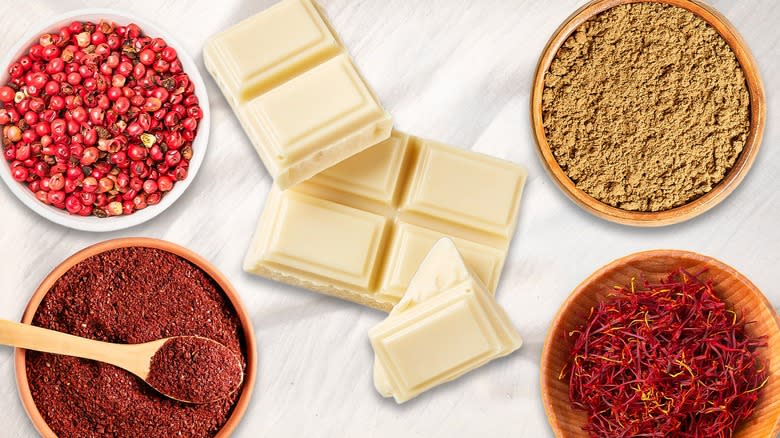
Chocolate lovers all over the world might argue about what the best chocolate is, whether it's the slight bitterness of dark chocolate, the sweet and creamy white chocolate, or the popular middle-ground milk chocolate. True fans probably love all three without prejudice, but some debate whether white chocolate is actually chocolate. This is because milk and dark chocolate contain cocoa solids, the elements of the cocoa bean that carry the flavonoids of chocolate. White chocolate doesn't have any cocoa solids in it, only cocoa butter, which is basically just the fat of the cocoa bean. However, white chocolate has a distinct flavor in its own right, and the silkiness of cocoa butter is behind that. Regardless of what's considered real chocolate, the buttery taste of white chocolate is a luxurious treat for anybody with a sweet tooth and is an amazing ingredient to eat or bake with.
While white chocolate is a satisfying candy on its own, it becomes a flavor delight when paired with certain spices. The almost neutral creamy profile is the perfect base for so many different tastes and plays well with spicier and tangier ingredients, taking it to new heights of surprising results. It also goes well with a number of fruits, flowers, herbs, and ingredients like coffee and matcha. As a classically trained cook, food writer, and someone who's worked with an artisanal chocolate maker since my youth, I've tasted a lot of pairings. These are some of the best spices to pair with white chocolate.
Read more: Chocolate Brands, Ranked Worst To Best
Vanilla
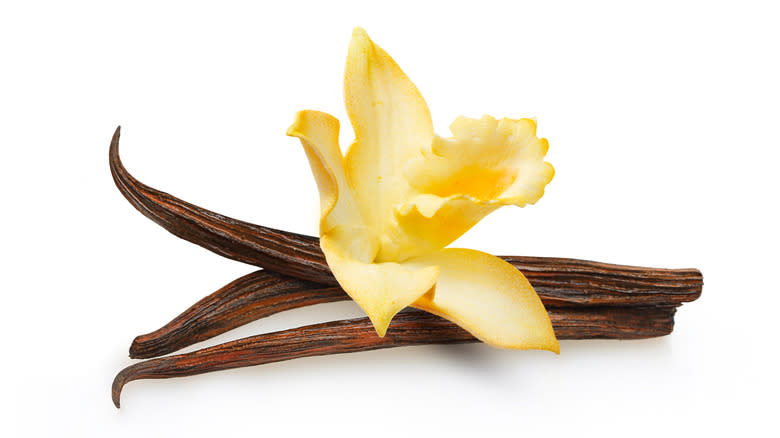
Many people mistakenly think that the flavor of white chocolate is vanilla, or that the absence of coco powder equals vanilla. This has caused much confusion with ice cream and gelato sellers across the world having a sweet cream or fior di latte (as it's called in Italy) option, as some have incorrectly assumed it would taste like vanilla. In truth, it's not uncommon for people not to realize that vanilla is, in fact, a spice, and a really distinct one at that. So while some white chocolate bars might also contain vanilla, it's not the dominant flavor of white chocolate. You'll most understand this when you buy local handmade chocolate that's been infused with vanilla bean or if you've done so yourself.
Vanilla and white chocolate are a heavenly combination since vanilla, can so clearly shine through the sweetened milky cocoa butter, but it's delicate enough that it does so without overpowering it. Look out for chocolate that uses real vanilla pods, you'll be able to see little black specks all over the chocolate, rather than vanilla flavorant or essence, which tends to have a more artificial taste.
Salt
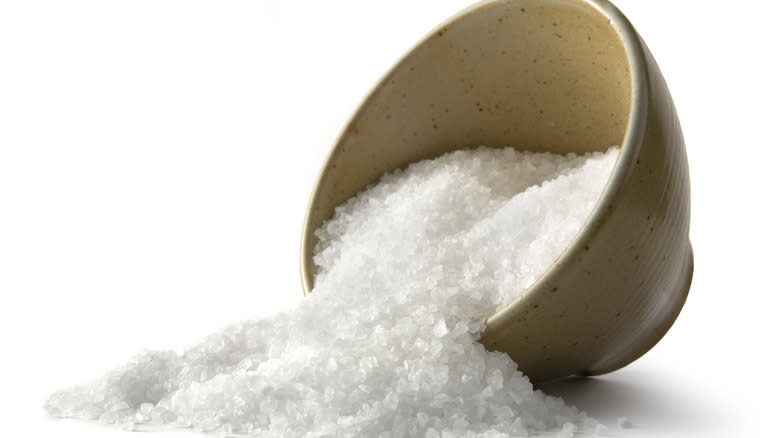
Salty and sweet work in almost anything, and white chocolate is no different. We've all seen salted caramel everything and dark chocolate with sea salt. For the same reasons that salt pairs well with those flavors, it's incredibly complimentary with white chocolate. A light saltiness is the perfect balance to the intense sweetness and pronounces the milkiness even more.
You can try this by making salted white chocolate chip cookies, adding a pinch of salt and a block or two of white chocolate into your bowl of oatmeal, or making sweet and salty white chocolate popcorn; you won't be able to get enough of it. There are also plenty of artisanal chocolate makers that offer a sea salt white chocolate bar, and we encourage you to get some from them and support smaller producers. An extra benefit is enjoying the slight crisp of salt flakes on your tongue; it's a textural pleasure.
Sumac
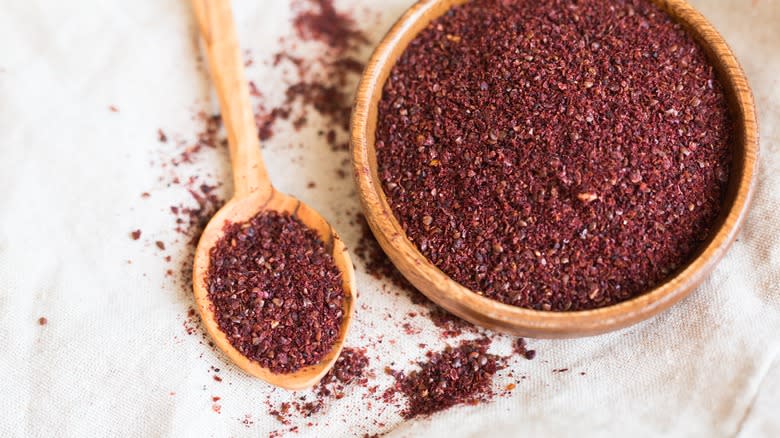
Sumac is a crimson-colored spice that is popular in the Middle East and countries like Iran and Turkey. What is actually a sour berry is dried and ground down into a deep red spice that brings a citrusy sharpness to foods like grilled meats, fish, salads, rice, and dips. It's sometimes called a dry acid because it's a powder with a tart taste and adds acidity to foods without the need to use things like lemon juice or vinegar. This acidity is what makes it the perfect spice to pair with white chocolate because it helps cut through the sweet creaminess of the chocolate and incorporates a subtle fruitiness that complements it without dominating it.
It's not as easy to find sumac and white chocolate slabs in stores, but it's easy to make your own sumac and white chocolate bark. Simply melt some white chocolate over a double boiler or in a saucepan with low heat, then pour it onto a sheet pan and sprinkle some sumac on top. You can add other toppings to your liking, and things like nuts or candied lemons would work great. You can find sumac in most large grocery chains or in the spice section of a Middle Eastern or Asian supermarket.
Lavendar
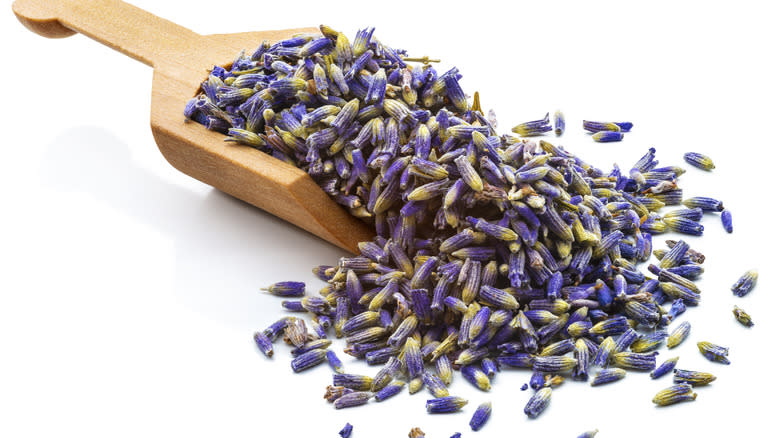
Lavender and white chocolate have become a sought-after pairing, and it's not uncommon to find this flavor combination among chocolate and dessert makers. The violet petals are so visually appealing against the ivory-colored chocolate that it's almost too pretty to eat. Still, the taste matches the beauty. The fine floral notes merge with the velvety nature of the chocolate to create a lightly perfumed confectionary that feels as elegant as it looks.
A simple way to enjoy this pairing is by making a lavender, white hot chocolate as a nighttime drink. Using dried lavender, you can infuse it with some milk and melt white chocolate into it over low heat. However, be careful not to use too much lavender, or it can turn soapy. All you need is a pinch to achieve enough of the floral aroma. Not only is this a decadent drink, but it's also the perfect choice before bed since lavender is known for its calming properties and ability to aid in better sleep.
Pink Peppercorns
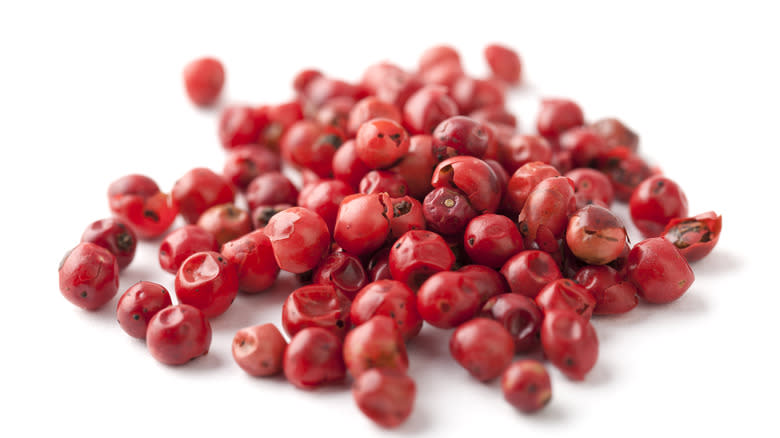
Another popular spice to pair with chocolate is pink peppercorn. It goes surprisingly well with all three types of chocolate: white, milk, and dark. We especially love it with white chocolate because the peppery yet fruitiness creates complexity that balances out the sugariness of white chocolate. Plus, it doesn't hurt that the pink is so striking against the white, making us eat with our eyes first.
You might be surprised to learn that pink peppercorns are not actually a type of pepper. In truth, they're a type of berry with a peppery taste, hence the name and the confusion. Even though they're not really pepper, they often get included in peppercorn mixes. However, they don't grind as easily as peppercorns, which can create problems with your grinder. Because they're slightly softer than peppercorns, they work best whole or lightly crushed with your fingers and sprinkled on top. The subtle spiciness of this dried berry adds an exciting touch to white chocolate, making your tongue tingle while enjoying the textural element of the slight crunch that it provides.
Cardamom
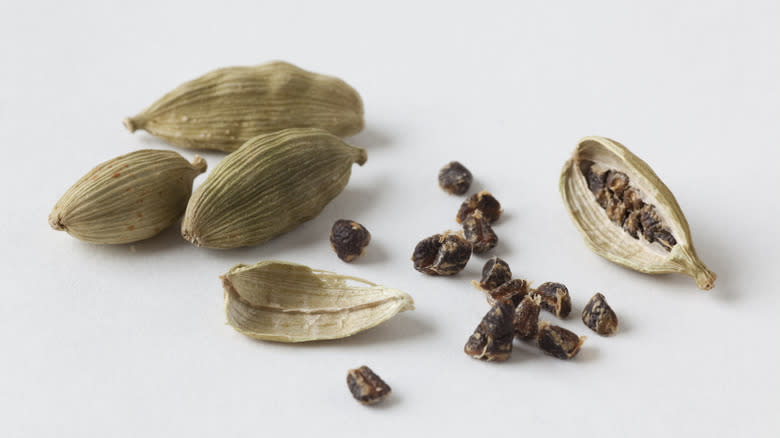
Cardamom is a warm spice that works incredibly well with white chocolate. In South Asia and the Middle East, cardamom is often part of various desserts and drinks, as well as plenty of savory dishes. This versatile spice brings complexity to anything and everything and often elevates a simple dish into something more fragrant and delicious. It can be polarising to people who are not used to its taste and might take some getting used to. Even for people who grew up eating it, it can be an unpleasant experience if you're the unlucky one who unknowingly bit into a whole pod while eating a biryani. However, when used correctly, it produces a beautifully layered palate to food without overpowering it. The slightly woody and citrusy aromas of cardamom make it one of the best spices to pair white chocolate with, adding incredible depth of flavor to the otherwise simple confectionary.
Saffron
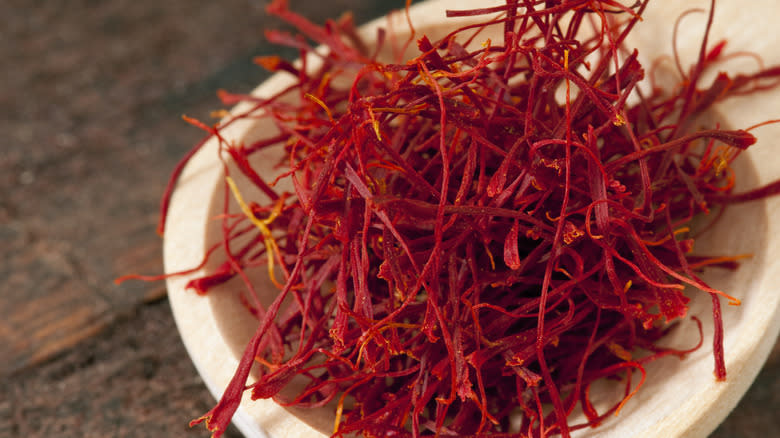
Saffron is a spice that tends to intimidate people. It's known to be expensive for a small amount, and people are too afraid to experiment with it in case it wastes it. Thankfully, with saffron, a little goes a long way, and all you need is a tiny pinch of the thin red threads to infuse it into your cooking and baking. This is especially suitable for white chocolate, which can be easily overwhelmed, so even less saffron is required to impart its fragrance to the candy.
Most of the world's saffron comes from Iran, where it's particularly loved. It features in Iran's national dish, tahdig, also known as saffron rice. The spice is also used a lot in North Africa, South Asia, and in some unlikely Nordic countries, too, like Norway and Sweden, where it's become heavily associated with Christmas time. The earthy and floral flavor of saffron is already quite delicate, so mixing it with white chocolate is perfectly poised to allow it to shine through, and it's subtle enough that it doesn't drown out the white chocolate either. It brings a beautiful amber color to whatever it's added to, so it's an easy way to create a magnificent swirl of color in your chocolate slab or to decorate your baked goods.
Cinnamon
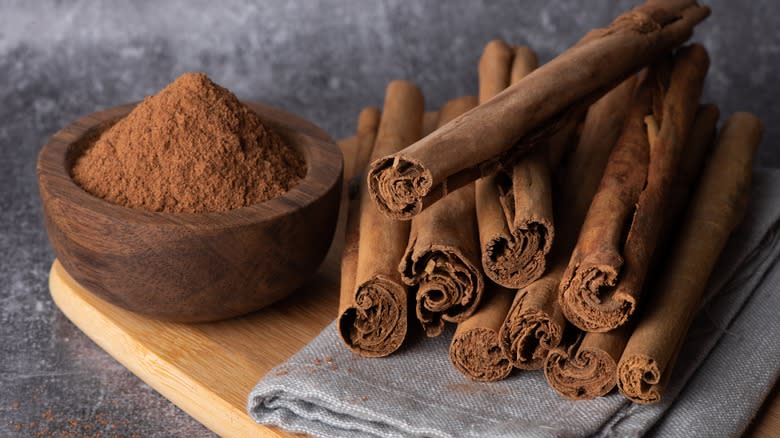
Cinnamon is another warming spice that pairs really well with all types of chocolate. Cinnamon is a favorite spice for many desserts, baked goods, and sweet drinks and is at the heart of pumpkin spice, a blend that's often infused into white hot chocolate — a drink that's as tasty and complex as it is decadent. The combination of cinnamon and white chocolate is an obvious one, and it can be seamlessly blended into tasty treats like cinnamon rolls, muffins, cookies, truffles, and chocolate barks. Additionally, it could even be beneficial to your health to add cinnamon to white chocolate, as there's evidence that cinnamon helps to lower blood sugar, and we all know that white chocolate, with its high sugar content, is likely to spike it — a match made in heaven.
Mint

You either love or hate the mint chocolate flavor, but it exists for a reason. The herbaceous cooling of mint herbs has a wonderful effect on chocolate of all kinds, and it's especially good with white chocolate, as it helps to push against the sweetness. It's worth a try, even if you don't like mint chocolate chip ice cream or mint chocolates, because it offers a different experience altogether. The cocoa butter taste provides a sweet nuttiness that the mint highlights.
However, the reason you think you don't like mint-flavored candies is likely because of the artificial or exaggerated aroma that's sometimes used, making it feel like you're eating toothpaste. If you stick to products that use fresh or dried mint herbs, whether it be spearmint or peppermint, you're going to find it much milder in menthol and more herbaceous than a peppermint or spearmint essence. Make a classic peppermint white hot chocolate or Christmas bark to enjoy this combination. And if you're feeling extra innovative, try using dried mint and see the incredible fragrance it adds to white chocolate.
Ginger
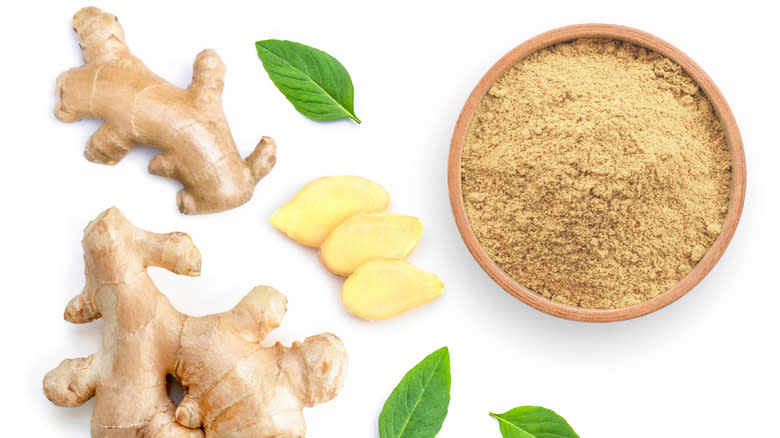
Ground ginger shouldn't be relegated to just gingerbread and cookies; it's an incredibly versatile spice that can add a delicate kick to many foods, sweet or savory. It's also delicious with white chocolate, as the slight spiciness of the ginger brings a pleasant heat to the buttery sweetness. This is quite an easy combo to work with, and there are many ways you could go with it. The most obvious is to use white chocolate chips in ginger cookies, but you could also dip ginger cookies or gingerbread into white chocolate and cover them completely or partially with it. Or you can make a white chocolate drizzle to create decorative patterns on your baked goods. Another tasty option is to make a white chocolate frosting for ginger cupcakes. For an especially festive breakfast around the holidays, jazz up your oatmeal with white chocolate chips, ginger, and cinnamon. You and your family will feel extra special.
Barberries
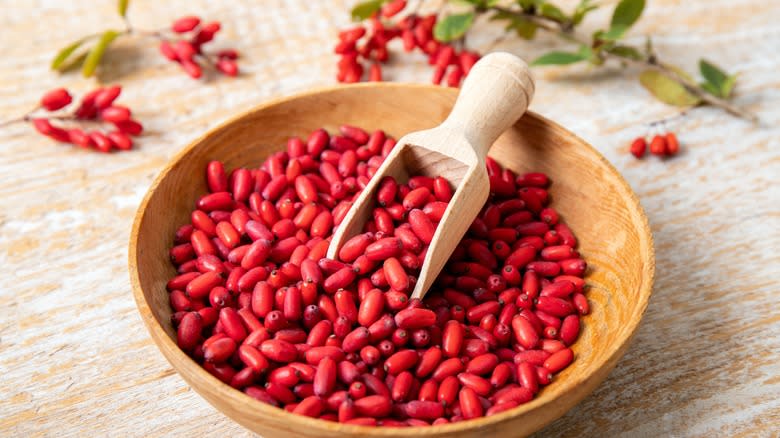
This might be a new ingredient for a lot of people, but barberries are the delicious tart berry that's a staple of Iranian cuisine. We already know berries and white chocolate are made for each other, so a berry in spice form is bound to be the perfect pairing for your next white chocolate creation. You'll have to make your own as it's highly unlikely you'll find barberries in your local chocolate brands since it's such a unique spice and not as easy to find outside of the cuisines it's known in. While barberries are used for things like jams and jellies in Europe, In Iran and the Middle East, they are dried and ground down into a powder, just like sumac, and they have a similar tartness but are less lemony and more cranberry-like.
If you're unable to find the spice, it's possible to use dried sour cherries or dried cranberries as a close substitute. The acidity of the spice brings life to white chocolate, and the fruitiness adds an interesting profile to the palate. A white chocolate bark sprinkled with barberries would work best to maximize the marriage of the two, but you can get even more creative and take these two ingredients anywhere you like.
Rose
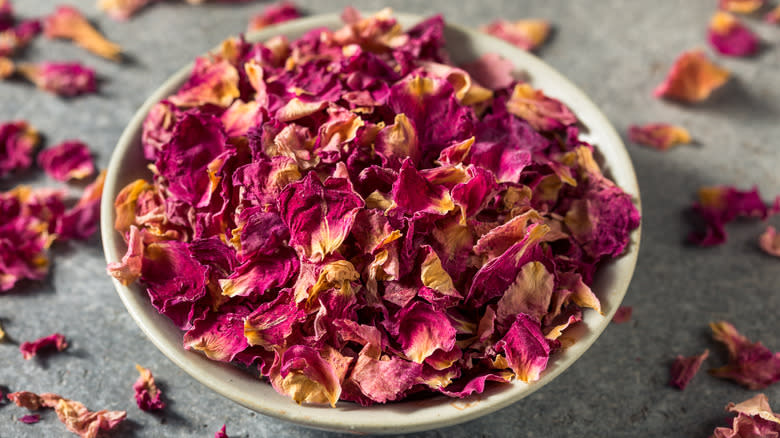
Rose has been used as a flavor enhancer for centuries in North Africa, West and South Asia. The light perfume it provides creates a powerful floral scent to drinks and desserts all over those cuisines. Usually, this is in the form of rosewater or rose essence, but using dried rose buds is another way to infuse it into foods and create stunning pink and purple flakes, making it appealing to food stylists and Instagrammers. Looks aside, using dried rose for its taste as a spice can be a way to celebrate it without the sometimes soapy effect that rosewater can have on food if too much is used. The spice is more subtle and earthy, and it adds a pleasant, sweet aroma to white chocolate.
There are numerous ways to enjoy rose and white chocolate. We think combining the two in mahalabiya is the way to go. This Middle Eastern dish is the 7th-century pudding that spawned several classic desserts. Many believe that the Italian panna cotta, the Spanish manjar blanco, and other types of milk puddings are based on mahalabiya. Typically, mahalabiya is flavored with rosewater, but we suggest making milk and white chocolate infused with dried rose base for the pudding and then sprinkling extra dried rose and some crushed pistachios on top for a decorative touch.
Lemongrass
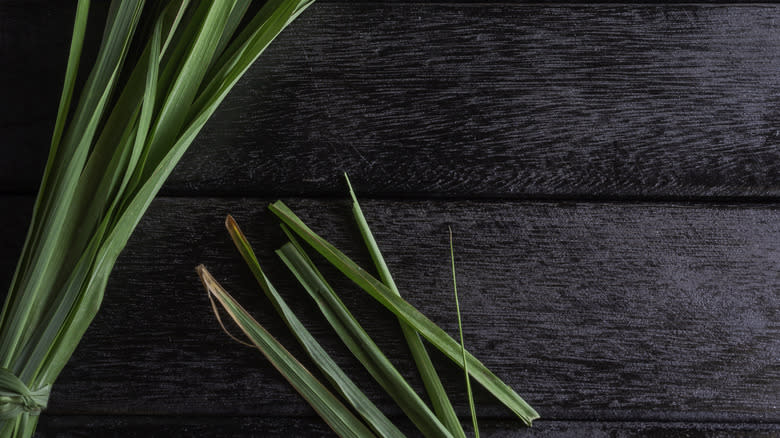
Lemongrass is one of the cornerstones of Thai cooking, and it's a very versatile plant used for making tea, broths, and curries. The plant itself is a natural repellant against mosquitos. Among the many uses of lemongrass, chocolate hasn't been one of the most common things it's paired with. However counterintuitive this pairing might be, the results are remarkable. The woody lemon scent gives the chocolate a slight freshness while being light enough that the cocoa butter is still pronounced. We think lemongrass white chocolate truffles are one of the best ways to enjoy this pairing, but for an easier choice, lemongrass panna cotta with a white chocolate shell is another elegant idea.
Basil
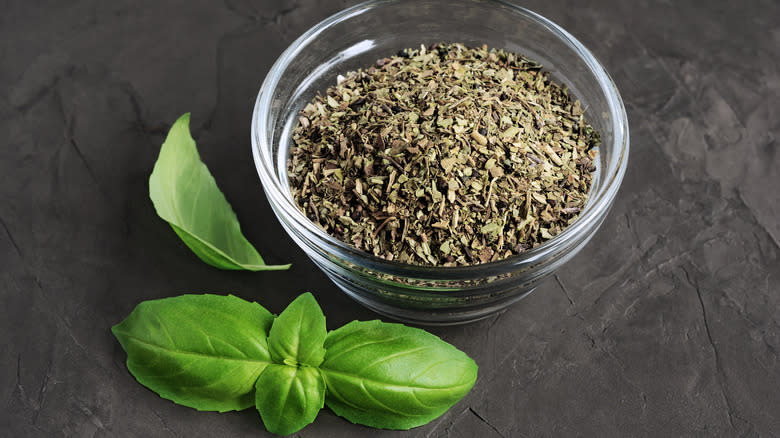
Basil has been popping up in various desserts for the past couple of years, and it's become a really fashionable ice cream and sorbet flavor. This herb is very pungent, and although it's mostly associated with Italian pizza and pasta sauce or as one-third of a Caprese salad, it makes for a gratifying addition to sweet foods, too. It's not the type of herb that can go with anything, though, and it's not as complimentary with milk and dark chocolate. However, it sings in a slab of white chocolate. The strong herbaceousness takes the chocolate from a food with high sugar content to an elevated and sophisticated confectionary. Using fresh herbs will have a stronger impact, but there's a benefit to using dried basil, as it has a more muted fragrance that won't overpower the chocolate.
Read the original article on Tasting Table.

